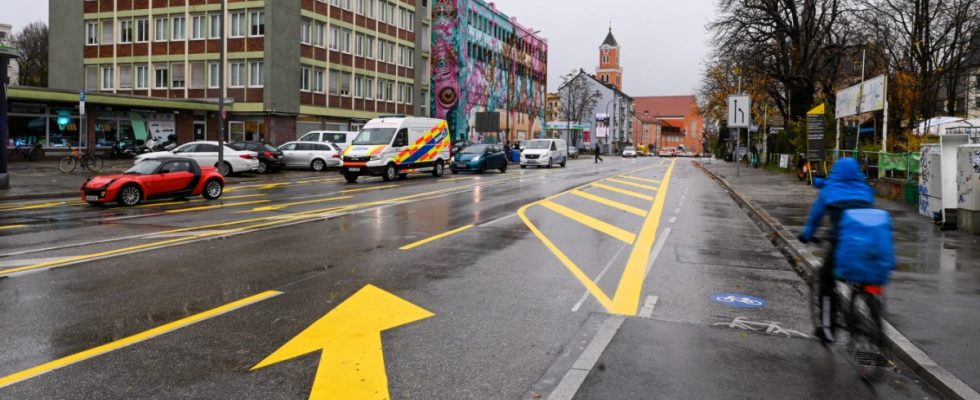The path down from Giesinger Berg was already dangerous 200 years ago. In the winter of 1840, a carriage overturned as it was leaving, which cost the entrepreneur Joseph von Utzschneider his life. In the following decades, the steep mountain alley was increasingly straightened; In addition, renovations reduced the gradient from 15 to four percent in places. Nevertheless, the Giesinger Berg is still a nuisance today – for cyclists and pedestrians. After all, the traffic management there is a relic from the times when cars dominated everything.
The city has been wanting to change this situation for a long time. That’s what the majority of people in Giesing also want. When it comes to the answer to the question of the optimal solution, opinions differ: While some are in favor of a foot and cycle path bridge over the Giesinger Berg, others favor the idea of a Giesinger church square presented in 2021, as a citizens’ initiative (BI) suggests. She wants to route car traffic between the Holy Cross and Martin Luther Church through an underground roundabout, which would create a place at the top “to linger and enjoy.” Cyclists and pedestrians who previously had to go through an underpass with stairs could also travel there.
The initiative founded by Clemens Marschner from Giesingen has received a lot of support for its plan. Among other things, the city council faction made up of the CSU and Free Voters (FW) called for a feasibility study; In addition, TSV 1860 Munich spoke out in favor of the church square solution. According to Marschner, a good 2,600 people support the associated petition. The signatures are expected to be handed over to the city this year. Here you have the chance to “beautify a place with potential and upgrade the center of Giesing,” says the founder of the citizens’ initiative and admits: “Unfortunately, the idea came a little too late.”
With this sentence, Marschner probably has the competing plans for a foot and cycle path bridge over the Giesinger Berg in mind. Many Giesingers have also been committed to this project for several years. The aim is to close the gap in the foot and cycle connection between the Gasteig and Harlaching, which would create a continuous path along the high bank of the Isar. For this purpose, a bridge is to be built from Am Bergsteig Street on the plateau of the Holy Cross Church over to Bergstrasse north of the Martin Luther Church. The city council’s building committee commissioned the planning of a design in July. The mobility department says the project is expected to be approved in the second half of 2024.
The pop-up cycle path on Giesinger Berg will remain for a year.
(Photo: Alessandra Schellnegger)
In addition to the bridge, there is a second transport project that is intended to improve the situation for pedestrians and cyclists on Giesinger Berg. This refers to the reconstruction of Martin-Luther-Straße and the intersection in front of the Holy Cross Church. Lanes for cars are being removed here so that cyclists and pedestrians have more space. In addition, three new traffic lights will be installed for them. The redesign of Martin-Luther-Straße has already begun. The cycle paths there will initially be temporarily marked yellow and widened; In return, one lane will be eliminated in each direction. In the future, there will also be less space for cars on Giesinger Berg, where one lane will be eliminated downhill, while two lanes will be retained uphill – because of bus route 68. All of these measures are part of a pilot project that will run until autumn 2024. The city council will then decide how to proceed.
The renovation of Martin-Luther-Straße and the bridge would bring “significant improvements” for pedestrian and bicycle traffic, writes mobility officer Georg Dunkel in response to the CSU and FW’s application for Giesinger Kirchplatz. In order not to slow down these projects, a feasibility study is currently not recommended. In any case, an underground roundabout “represents a major structural and traffic planning challenge,” says Dunkel. “Due to the difficult topography and a shortage of space, there are concerns as to the extent to which such a structure would even be possible.”
Clemens Marschner wants to stick to the church square idea, even if the bridge comes. “It’s not mutually exclusive,” he says. In any case, Marschner emphasizes that his plans are “an urban planning concept and not a transport project” – this has often been misunderstood by the public. However, in its advertising video, the BI praises the church square concept as an “alternative” to the bridge. Nevertheless, Marschner is convinced: “Once an idea is in the world, it will not disappear.” He and his colleagues definitely want to continue working on it.
A panel discussion as part of the adult education center’s “Giesinger Talks” this Monday will focus on the bridge over the Giesinger Berg, the idea of a church square and other cycling projects in the district. It starts at 7 p.m. in the Giesinger Bahnhof cultural center. Admission to the event is free.

